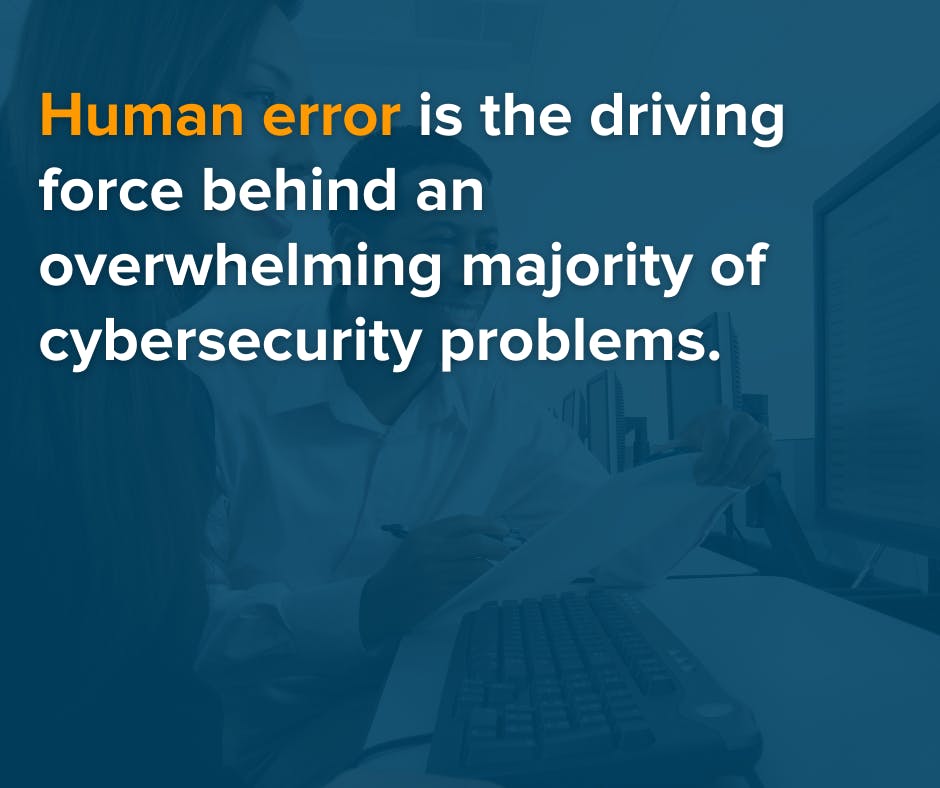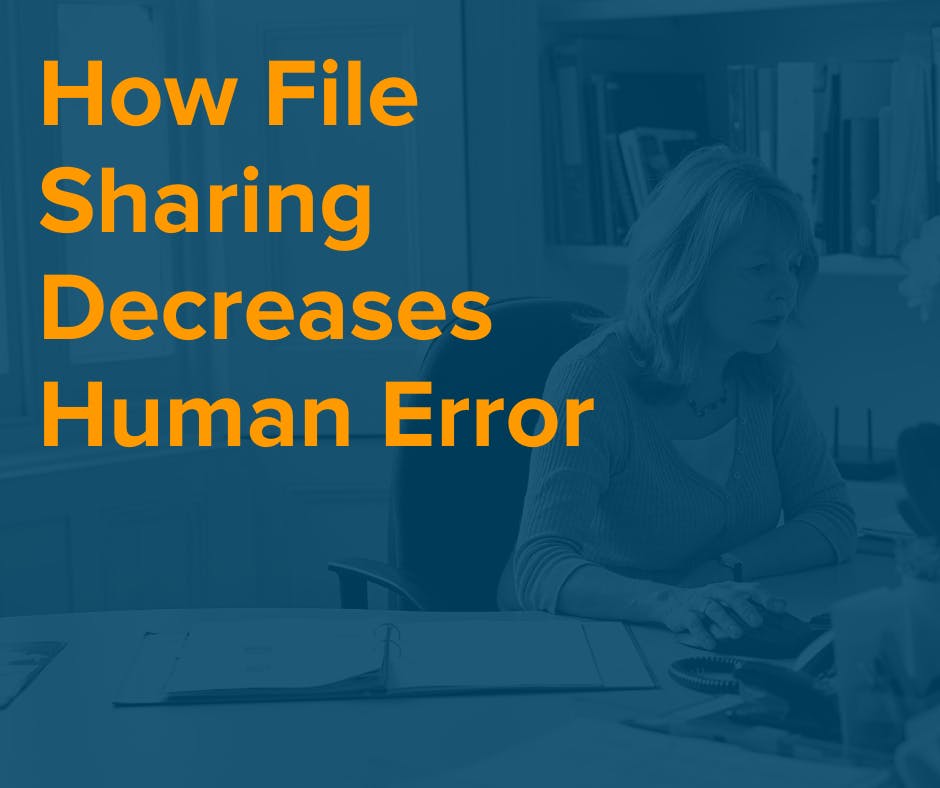Today, the vast majority of businesses rely on the internet to help them carry out their daily operations. If businesses do not have access to the internet, there is a good chance that their daily operations would grind to a halt. Because so many companies are heavily reliant on the internet, it should come as no surprise that hackers are working very hard to break into the sensitive data banks of companies. They can steal financial data, gather a tremendous amount of information about their customers and clients, and even use this information to blackmail the company into paying out even more money.
So, how do hackers break into these sensitive databases? Mainly, they get in through human error. While the company might have a strong cybersecurity team behind it, these security measures are only as strong as the weakest link. That’s why it’s so important to take a closer look at human error, how it leads to cybersecurity issues, and what can be done to reduce human error through professional file-sharing services.
The Role of Human Error in Cybersecurity Breaches
First, it is essential to look at the role human error plays in some of the biggest cybersecurity breaches. Companies work hard to establish robust cybersecurity protocols, but if their employees don’t know how to follow them and abide by the protocols put into place, the company is going to be at risk. Some of the most significant examples of how human error could lead to a major cybersecurity breach include:
Poor Password Hygiene
It is critical to make sure all employees change their passwords from time to time. While people get annoyed when they have to change their passwords every so often, it is essential for reducing the chances of someone using an old, compromised password to access the network or server. Some employees might not even know how to create a strong password—it’s your job to educate them on how to do so. If employees do not change their passwords regularly, or if they use the same password for everything, cybercriminals will have an easier time getting the password and accessing just about every file on the server.
Issues Getting Emails to the Right Person
Email misdelivery is another major issue related to cybersecurity breaches. This isn’t necessarily the system messing up, but it could be the employee sending the email to the wrong person. They might select the wrong autofill email address or they might think that the email is about something else entirely.
Sometimes, these emails contain sensitive information, and they might be sent to addresses of people who are either untrustworthy, someone completely unknown to the person, or even a potential criminal. Then, the sensitive information in the email could be released to the public or used to blackmail the company.
Not Patching Security Issues
It is important for companies to work continuously to identify and rectify issues related to their cybersecurity. When a vulnerability is discovered, it is imperative to patch the problem as soon as possible. Sadly, there are a lot of companies that do not encourage their IT teams to follow this critical, basic cybersecurity practice. If vulnerabilities are not detected and patched, the company is going to be vulnerable and put at risk.
Not Updating Computers After Patches
In addition, after a patch has been made, it is important for companies to have their users restart their computers to make sure the patch is working as it should. People never seem to have a convenient time to turn off and reboot their computers. As a result, the patch is never applied. Companies might want to force all of their computers to reboot in the middle of the night when it won’t bother anyone. Or, they might want to give people the opportunity to schedule a specific time in advance to turn off and turn on the computers.
Bad Access Control
Finally, lousy access control practices also lead to cybersecurity issues, as companies are not practicing the guideline of least-required access. This means that people only have access to the files they need to do their jobs. This doesn’t mean that the person isn’t trusted, it just means that if the person’s login credentials are compromised, the criminal does not have access to the entire network or server. They only have access to the files that the specific person had access to.
These are just a few of the most prominent examples of how human error could lead to a significant cybersecurity breach. Companies need to make sure they follow a few critical tips if they want to reduce the risk of dealing with a major cybersecurity issue.
How To Reduce Human Error
Fortunately, there are a few steps companies can take to reduce the cybersecurity issues created by human error. You need to abide by the best practices in the industry to make sure your information is adequately protected. Some of the best practices that companies should follow include:
Invest in the Right Training
If you want to reduce the chances of someone breaking into your network, you need to make sure your employees have been educated appropriately. In this day and age, if companies do not train their employees on the basics of cybersecurity, they run the risk of having a data breach. Employees need to be trained on the risk of phishing attacks and what they look like, and they need to understand what to do if they think their credentials have been compromised. Training can reduce the chances of a data breach at your company.
Use Two-Factor Authentication
Another critical step that companies need to take to reduce the risk of human error is to use two-factor authentication. What this means is that instead of requiring only one set of login credentials to access files, companies need to require two. There are plenty of easy ways to implement this. For example, companies might want to follow a successful username and password combination with a request for text message verification. This is important because if an employee surrenders their login credentials in a phishing attack, the hacker still won’t be able to access the files.
Follow the Least-Required Access Policy
Companies also need to follow a policy of least-required access. What this means is that companies should not give someone access to files unless they are necessary to do their jobs. If someone has their login credentials stolen, the hacker will not gain access to the entire server. Instead, they will only gain access to the files that the individual had access to.
Monitor All Activity on the Network
Businesses also need to make sure that they monitor all activity on the network. People need to be asked to log in to everything. Then, the business needs to store who logs in where. If the company notices that there are a lot of people trying to log in to things they shouldn’t be logging into, the company needs to investigate this and figure out what is going on. Then, if there is a serious issue, the company needs to do something about it. At the same time, the company will not be able to do anything if they do not know that someone is trying to hack into their files. This type of visibility and transparency is essential for ensuring the company keeps its information safe.
Actively Test Your Security Measures and Patch Vulnerabilities
Finally, companies need to make sure that they test all of their security measures on a regular basis. Many companies believe that as long as they test their firewall (and pass the test) once, this is good enough. In reality, this is not the case. Just as the company is working hard to protect its files, there are a lot of hackers working to find vulnerabilities. Companies need to test the firewall first to see if there are any issues that they can plug before hackers exploit them. Companies might even want to hire penetration testers to help them find and fix problems.
These are just a few of the most important practices that businesses need to follow to reduce the chances of human error leading to a significant cybersecurity breach. File-sharing can help companies appropriately mitigate this risk and protect their confidential information.
The Role of File Sharing
There is another major issue that companies need to consider if they want to keep their files safe. That comes in the form of file sharing. Remote work has become a norm, meaning employees might not be able to pass their files to someone else physically. The files need to be sent to someone else using the digital world. While files are frequently encrypted at the start and end of the transmission, they are not always encrypted in the in-between. This is a severe vulnerability hackers can and do exploit.
Therefore, it is critical for companies to make sure they invest in software that ensures these valuable files are protected. That is where SmartFile can help you. SmartFile provides a comprehensive service that can make sure all data is protected and that it does not end up in the wrong hands. SmartFile uses file and data stream encryption to protect files. Data is sent through a secure internet channel, which will encrypt the stream with SSL. This special type of protection makes it very hard for someone to crack the code and read the files.
Once the files are on the server, they are encrypted before being stored. This makes it even harder for someone to read sensitive data and take advantage of security issues.
SmartFile also provides password-protected logins. That means that if someone wants to read the file, they would need to have the file and the password to open it. This is an extra layer of security necessary to protect files in the modern era. You can manage your files and control precisely who accesses them. Furthermore, if someone accesses the files, you will have a paper trail that you can use to figure out who is accessing what and when they tried to access it.
These granular permissions are vital because you want total control over who can access what. You can authorize file access to certain people only, ensuring your files are adequately protected. This creates a virtual safe for your files, which can instill confidence in your managers, as well as your employees and clients.
You need to think about your file security regularly to make sure that you are taking the appropriate measures. If you are concerned about your file security, you need to reach out to a professional who can help you find the right tool to protect your information. SmartFile can do that for you.
Trust SmartFile To Help Take Care of Your Files
If you’re looking for a team of professionals to help you protect your confidential information, it would be our pleasure to help you. At SmartFile, we are proud to provide you with access to an exceptional system that can help you improve the productivity of your company and its staff, as well as reduce the risk of cybersecurity issues created by human errors. We can ensure that your files are encrypted from start to finish, reducing the chances of someone intercepting them in transit. If you would like to learn more about how we can help you, please contact us today.



